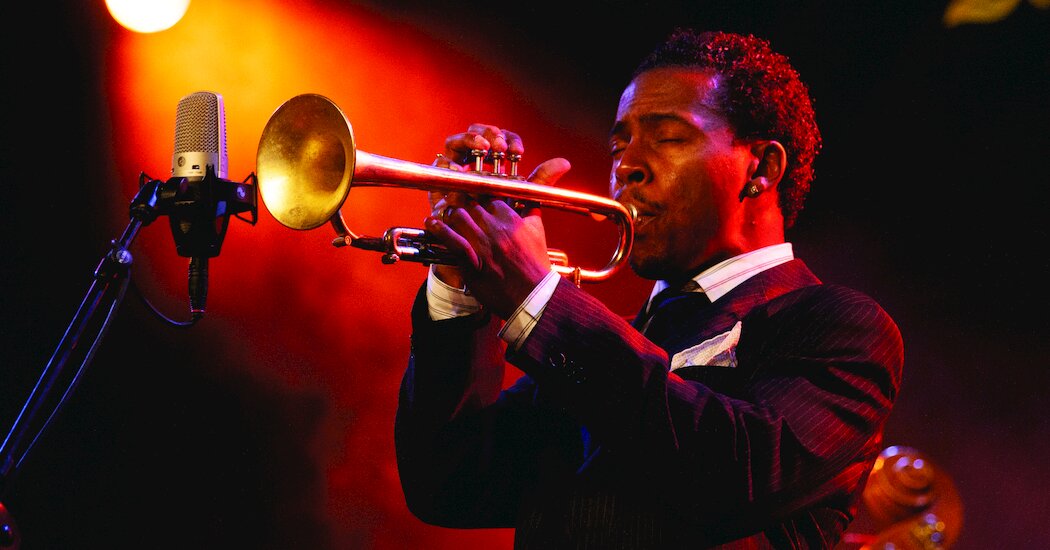
Roy Hargrove and Mulgrew Miller’s Glorious Duets
07/21/2021On a snowy evening in January 2006, the trumpeter Roy Hargrove sped from Newark Airport to Merkin Hall, on the Upper West Side of Manhattan, to play a rare duet concert with the esteemed pianist Mulgrew Miller. He got there just in time: There was no room for a rehearsal or even a proper soundcheck; they selected the set list while waiting in the wings, just before going onstage.
The two had long been in each other’s orbit, but they’d hardly ever played alone together, so they chose almost entirely standards, the common tongue of the jazz tradition. Their instruments blended effortlessly — just as they did nearly two years later, when the musicians came together again at Lafayette College in Pennsylvania, where Miller sometimes taught, for another duet.
Those two performances are collected on “In Harmony,” a double album from the archival jazz label Resonance Records arriving on vinyl and CD. Only select tracks will be available on streaming services.
The album is a low-key triumph, and a worthy addition to Black American music’s inventory of great trumpet-piano duet recordings, including the famous sides that Louis Armstrong and Earl Hines made in the 1920s, and the underrecognized LP that Oscar Peterson recorded with Clark Terry in 1975. There’s something satisfying about the neatness of the format — the clarity of the roles, the separation of powers — that allows a trumpeter and a pianist to let loose within the gift of structure.
Both Hargrove and Miller died in recent years, at ages 49 and 57, but despite being relatively young, they’d each achieved a kind of hallowed-elder status. Both had moved to New York from the South, roughly a decade apart, and they became shaped by the straight-ahead jazz renaissance going on in Manhattan in the 1980s and ’90s. At the same time, they never fell out of touch with the blues and gospel traditions, which they had learned from the inside out as youngsters.
On the opening track of “In Harmony,” a nine-minute sprint through Cole Porter’s “What Is This Thing Called Love,” Miller tosses together bluesy rumbles, fast-break bebop and the occasional passage of stride piano. Hargrove’s smartly dazzling solo is laced with bebop callbacks — to Thelonious Monk’s “Rhythm-a-Ning” and Tadd Dameron’s “Hot House” — yet his style transcends: He has a buttery and elegantly coiled attack that harks to Clifford Brown, and the acuity to follow Miller’s lead into postmodern harmonic leaps.
Hargrove grew up in Texas, quiet and reclusive, but by his midteens he had found his vocation and was becoming known as a prodigy. He moved to New York at 20, and for months he spent almost every night at Bradley’s, a bustling jazz haunt in Greenwich Village with a luxurious grand piano but no drum kit. The club was a laboratory and a proving ground, and while there he grew close with various older musicians. Miller was one of them.
Hailing from Mississippi by way of Memphis State University, Miller was a pianist who could fill any assignment. As his career went on, he tended to do the assigning himself: Throughout the 2000s, he led a trio that hewed to an acoustic-jazz format but left plenty of room for Miller’s vast palette of influences to shine — the stride of Art Tatum, the bebop of Bud Powell, the block chords of Erroll Garner, the soul piano of Donny Hathaway or Aretha Franklin, the gospel playing of James Cleveland.
He also took close notes on the non-pianists he worked with. Toward the beginning of his career, in the early 1980s, Miller spent three years playing in the band of the trumpeter Woody Shaw, who did more than perhaps any other musician of his era to expand the possibilities of harmony and imbrication in modern jazz. Miller learned to pour those lessons into his piano playing, and you can hear it across “In Harmony,” including on “Invitation,” the Bronislaw Kaper standard, when Hargrove and Miller trade fours in a high-velocity repartee. At times, Miller cycles through harmonies around a fixed point, and Hargrove cuts into them at an angle, traveling in leaps. In other cases, Miller improvises in chunky, rhythmic sequences of chords — no melody needed.
Miller and Hargrove bring the same level of intense focus to the ballads they play, including Benny Golson’s “I Remember Clifford” and Monk’s “Ruby My Dear”; on most of those, Hargrove switches to the fuller-toned fluegelhorn. Throughout, both players are at the height of their powers, and it’s arresting to hear them up close, in such rich detail. It’s also rare, in today’s jazz generation, for musicians to approach standards with this level of hands-on commitment and devotion.
“In Harmony” was recorded in far grander rooms than Bradley’s, before much-less-roisterous audiences, but it’ll leave you musing on what a night at the club might have felt like: the stripped-down instrumentation; the intimacy of the exchange; the standard jazz repertoire, renewed through camaraderie and fresh ideas.
Roy Hargrove and Mulgrew Miller“In Harmony”(Resonance)
Source: Read Full Article

